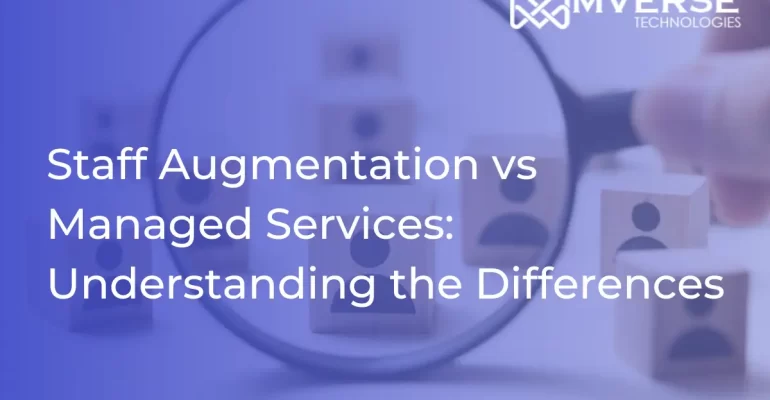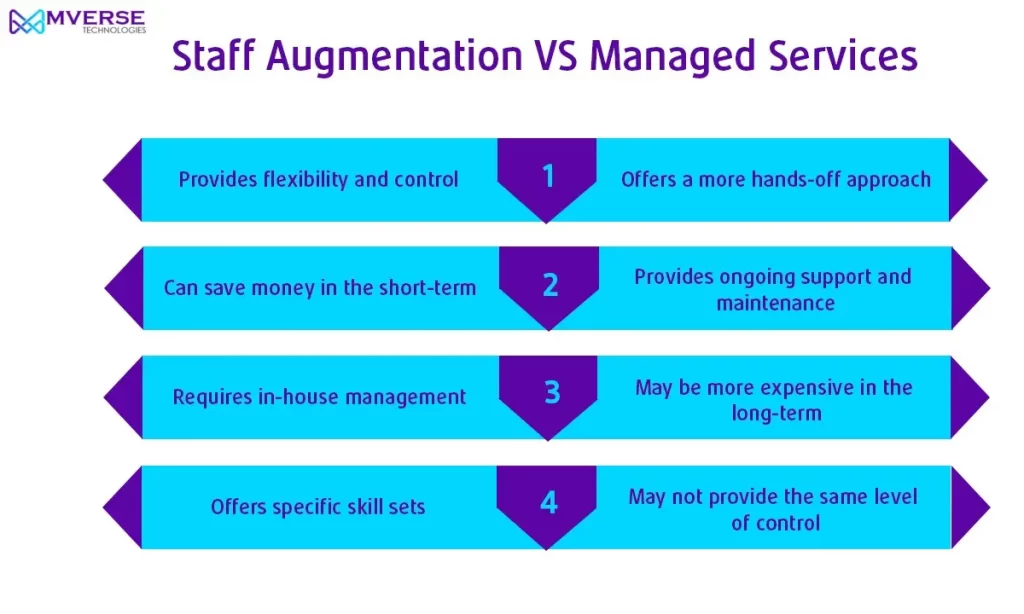Staff Augmentation vs Managed Services: Understanding the Differences

Staff Augmentation vs Managed Services: Understanding the Differences
As organizations grow, they often face challenges in scaling their IT departments.
One of the biggest challenges is determining the best way to manage their IT resources. Staff augmentation and managed services are two popular options that organizations can consider.

Staff augmentation involves hiring temporary staff to fill skill gaps in an organization. This approach is used when organizations need to fill a specific skill gap or increase their capacity for a short period.
On the other hand, managed services involve outsourcing IT functions to a third-party vendor. This approach is used when organizations need to outsource their IT functions to a vendor who can provide the necessary expertise and resources.
Key Takeaways
- Staff augmentation involves hiring temporary staff to fill skill gaps in an organization, while managed services involve outsourcing IT functions to a third-party vendor.
- Staff augmentation is ideal for organizations that need to fill a specific skill gap or increase their capacity for a short period, while managed services are ideal for organizations that need to outsource their IT functions to a vendor who can provide the necessary expertise and resources.
- Both staff augmentation and managed services have their pros and cons, and organizations need to evaluate their needs and budget before deciding which approach to take.
Understanding Staff Augmentation
Staff augmentation is a flexible and cost-effective approach to supplementing your existing team with external talent.
It involves temporarily hiring skilled professionals filling skill gaps or meet specific project requirements. Unlike traditional hiring, staff augmentation allows you to scale your workforce up or down as needed, providing a strategic solution that aligns with your business goals.
Staff augmentation is often compared to independent contractors, dedicated teams, and time and material (T&M) models. While each model has its advantages and disadvantages, staff augmentation offers a unique blend of flexibility, scalability, and cost savings.
One of the advantages of staff augmentation is the ability to hire skilled professionals for short-term or long-term projects.
Short-term staff augmentation is ideal for projects that require specialized skills for a limited duration.
Long-term staff augmentation involves hiring professionals for extended periods and is suitable for projects with a long development lifecycle, ongoing maintenance, or continuous support requirements.
Another advantage of staff augmentation is the ability to hire professionals who work directly at your office premises or remotely.
On-site staff augmentation fosters real-time collaboration, making it suitable for projects that require close coordination between in-house and external teams.
Remote staff augmentation allows you to hire experts from different geographical locations, offering access to a diverse talent pool without the constraints of location.
Project-based staff augmentation is tailored for specific tasks or projects, while team-based staff augmentation involves hiring a complete team of professionals.
A dedicated team ensures comprehensive project coverage, leading to efficient development and faster delivery.
Choosing the right staff augmentation model depends on your project requirements, budget, and timeline. Evaluate the scope of your project, assess the skills needed, and consider the duration of engagement.
Additionally, factor in communication preferences, as seamless collaboration is vital for successful outcomes.
Related Posts
- Types of IT Staff Augmentation Services – How To Choose One
- What is IT Staff Augmentation? Why do you need it?
Exploring Managed Services

One of the main advantages of managed services is that they offer a more comprehensive and proactive approach to IT management compared to staff augmentation.
With managed services, the provider takes on the responsibility of monitoring and maintaining the systems, ensuring that they are running smoothly and addressing any problems before they become major issues. This can help to minimize downtime and improve overall system performance.
Another key advantage of managed services is that they often provide a more cost-effective solution compared to staff augmentation.
With staff augmentation, companies are responsible for hiring and managing their own IT staff, which can be expensive and time-consuming.
In contrast, managed services providers typically offer a range of service packages that are priced based on the level of support required, making it easier for companies to manage their IT costs.
Managed services can also provide a higher level of expertise compared to staff augmentation.
Managed services providers typically have a team of specialized professionals with a wide range of skills and experience, which can be particularly beneficial for companies that have complex IT environments or require specialized support.
Overall, I believe that managed services can be a valuable solution for companies looking to outsource their IT management. With a more comprehensive approach, cost-effective pricing, and access to specialized expertise, managed services can help companies to improve their IT performance while reducing the burden of managing their own IT staff.
Staff Augmentation Vs Managed Services

When it comes to outsourcing IT services, there are two primary models to choose from: staff augmentation and managed services.
While both options have their advantages and disadvantages, the choice ultimately depends on your specific business needs.
Staff Augmentation
Staff Augmentation is an outsourcing strategy where companies enlist tech talents to fill necessary team positions. This approach allows businesses to seamlessly scale their teams according to their specific requirements.
One of the key advantages of staff augmentation lies in the expertise it offers. Typically, outsourcing partners analyze the knowledge and skills required by in-house teams and supplement them with suitable IT professionals. This not only addresses talent shortages but also enhances the overall performance of internal teams.

Why Choose Staff Augmentation?
- Flexible Outsourcing: Staff augmentation provides a flexible means to outsource skilled IT resources, integrating them seamlessly into your internal IT team. Managed by a staff augmentation vendor, this process reduces the company’s expenses, time, and effort typically associated with hiring full-time staff members.
- Cost Efficiency: With this model, you only pay fees according to the augmented staff’s contract, while administrative and organizational expenses are handled by the vendor, enhancing cost efficiency.
- Priority to Your Project: Developers in IT staff augmentation models are highly motivated to contribute to projects, ensuring your project remains the top priority.
- Access to a Global Talent Pool: IT Staff Augmentation breaks the limitation of local developers, granting access to a vast global talent pool, and enabling you to select the best developers for your projects, regardless of location and time zone.
Managed Services
Managed Services is a model where a dedicated team operates independently on the project, typically overseen by an outsourced project manager. Here, risks and responsibilities are shared between the client and the dedicated team.
When to Opt for Managed Services?
- For projects that require a team of experts who can manage the entire project from start to finish.
- For businesses that require a dedicated team to oversee the project and ensure its success.
- For projects that require a high level of expertise and experience, where the client may not have the necessary skills in-house.
In conclusion, understanding your project’s specific needs and your level of involvement in the process is key to selecting the right IT outsourcing model, ensuring a seamless and successful collaboration between your company and the external team.
Related Posts:
- What is IT staff augmentation – Process Flow, Benefits & Drawbacks
- 7 Scenarios When Leveraging Staff Augmentation is the Right Choice
Other Staff Augmentation Comparisons

When it comes to hiring additional staff, there are several options available, including staff augmentation and managed services. However, there are other comparisons to consider when deciding which option is best for your business.
Staff Augmentation vs Offshore Development Centers
Offshore development centers (ODCs) are a popular option for businesses looking to expand their development capabilities. ODCs are typically located in countries where labor costs are lower, such as India or the Philippines.
While ODCs can be a cost-effective option, they may not be the best fit for all businesses. ODCs require a significant investment in infrastructure and resources, and there may be cultural and language barriers to overcome.
Staff augmentation, on the other hand, allows businesses to hire additional staff without the need for a significant investment in infrastructure.
Staff Augmentation vs Time and Material (T&M)
Time and material (T&M) is another option for businesses looking to hire additional staff. T&M contracts typically involve paying a set hourly rate for the work performed by the contractor.
While T&M contracts can be a flexible option, they may not provide the same level of control and oversight as staff augmentation. With staff augmentation, businesses have more control over the hiring process and can ensure that the staff they hire have the necessary skills and experience to meet their needs.
In conclusion, while staff augmentation and managed services are two popular options for businesses looking to hire additional staff, there are other comparisons to consider. By weighing the pros and cons of each option, businesses can make an informed decision that meets their needs and budget.
Conclusion

In conclusion, both staff augmentation and managed services have their advantages and disadvantages. Staff augmentation provides the flexibility and control to manage a project in-house, while managed services offer a more hands-off approach that can save time and resources.
When deciding between staff augmentation and managed services, it is important to consider the specific needs of your project, including the level of expertise required and the duration of the project. If you have a short-term project or need a specific skill set, staff augmentation may be the better option.
On the other hand, if you have a long-term project or need ongoing support, managed services may be more beneficial. Managed services can provide a team of experts who can handle all aspects of the project, including maintenance and support.
Ultimately, the decision between staff augmentation and managed services will depend on your unique situation. It is important to carefully evaluate your needs and weigh the pros and cons of each option before making a decision.
Overall, both staff augmentation and managed services have their place in the business world. It is up to each individual organization to determine which option is best for their needs.
Frequently Asked Questions
What is the difference between staff augmentation and outsourcing?
Staff augmentation and outsourcing are two different models of hiring external resources. Outsourcing involves transferring the responsibility for a business process or function to an external service provider. Staff augmentation, on the other hand, involves hiring additional staff to work alongside existing staff to complete a project.
What is staff augmentation services?
Staff augmentation is a type of outsourcing in which a company hires additional staff to work alongside existing staff to complete a project. Staff augmentation services are typically provided on a temporary basis and are used to supplement existing staff during peak workloads or to provide specialized expertise.
What is the difference between staff augmentation and consulting services?
Consulting services are typically used to provide expert advice and guidance on a specific project or business process. Staff augmentation services, on the other hand, are used to provide additional staff to work alongside existing staff to complete a project.
What is the difference between staff augmentation and professional services?
Professional services are typically provided by specialized firms that provide expertise in a specific field. Staff augmentation, on the other hand, involves hiring additional staff to work alongside existing staff to complete a project.
What is the managed services model?
The managed services model is a type of outsourcing in which a company contracts with an external service provider to manage and support a specific business process or function. Managed services providers are responsible for providing the necessary resources, expertise, and technology to support the business process or function.
What is the transition from staff augmentation to managed services model?
The transition from staff augmentation to the managed services model involves moving from a temporary staffing model to a more permanent outsourcing model. This transition typically involves a change in the scope of services provided and a shift in responsibility from the client to the managed services provider. The managed services provider is responsible for managing and supporting the business process or function, while the client retains overall control and oversight.
